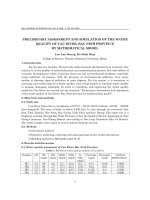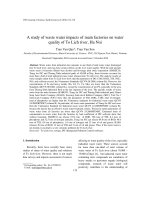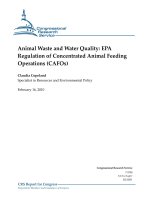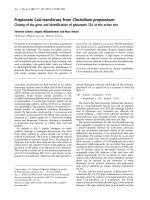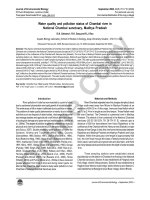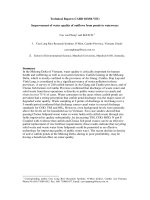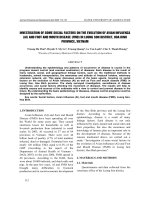Runoff and water quality of bui river at headwater catchment in luong son district hoa binh province
Bạn đang xem bản rút gọn của tài liệu. Xem và tải ngay bản đầy đủ của tài liệu tại đây (2.69 MB, 39 trang )
MINISTRY OF AGRICULTURE AND RURAL DEVELOPMENT
VIETNAM FORESTRY UNIVERSITY
STUDENT THESIS
RUNOFF AND WATER QUALITY OF BUI RIVER AT HEADWATER
CATCHMENT IN LUONG SON DISTRICT,
HOA BINH PROVINCE.
Major: Natural Resources Management
Code: D850101
Faculty: Forest Resources and Environmental Management
Student: Dương Tuấn Anh
Student ID:1153092241
Class: K56 Natural Resources Management
Course: 2011 - 2015
Advanced Education Program
Developed in collaboration with Colorado State University, USA
Supervisor: Dr. Bùi Xuân Dũng
Ha Noi, October/2015
ACKNOWLEDGEMENT
I would like to express my sincere gratitude to Dr. Dung and Prof: Lee Mac
Donald providing continuous encouragement and enthusiastic support during the research
work in. I greatly appreciated the help provided for by the Lam Son hydrometeorology
station provided for me data, laboratory of Vietnam Forestry University and Institute of
Chemistry in Vietnam Academy of Science and Technology helped me to analysis water
sample, and would especially like to thank Mss. Huyen, Mss. Xuan who helped me
directly.
TABLE CONTENT
ACKNOWLEDGEMENT
TABLE CONTENT
LIST OF TABLE
LIST OF FIGURES
ASBTRACT........................................................................................................................... 1
I. INTRODUCTION .............................................................................................................. 2
1.1. Introduction ..................................................................................................................... 2
1.2. Overview of the previous research issues.......................................................................3
II. OBJECTIVES ................................................................................................................... 5
III. STUDY SITE AND METHODS ..................................................................................... 5
3.1. Study site......................................................................................................................... 5
3.2. Methods .......................................................................................................................... 8
3.2.1. Identified the boundary of headwater catchment of Bui River .................................... 8
3.2.2. Runoff measurement .................................................................................................... 9
3.2.3. Rainfall measurement ................................................................................................ 10
3.2.4. Water quality measurement ....................................................................................... 11
IV. RESULTS AND DISCUSTION ................................................................................... 21
4.1. Parameter characteristics of Bui River’s headwater catchment .................................... 21
4.2. Flow regime characteristics of Bui River at headwater catchment. ............................. 23
4.3. Water quality of Bui River............................................................................................ 28
V. CONCLUSION ............................................................................................................... 34
REFERENCES .................................................................................................................... 35
LIST OF TABLE
Table 1. Climate indicators at Lam Son commune Luong Son district, Hoa Binh province 6
Table 2. Parameter characteristics of headwater catchment of Bui River ........................... 22
LIST OF FIGURES
Figure 1. Location of study site at Lam Son commune, Luong Son district, Hoa Binh
province ................................................................................................................................. 5
Figure 2. Flow chart of identify catchment boundary ........................................................... 8
Figure 3. Illustration graph for discharge measurement ....................................................... 9
Figure 4. Vietnamese rain gage measurement. .................................................................... 11
Figure 5. Boundary of Bui River’s headwater catchment ................................................... 21
Figure 6. Rainfall and discharge of Bui River from 2004-2014. ......................................... 24
Figure 7. Relationship between monthly runoff and monthly rainfall ................................ 25
Figure 8. Relationship between monthly runoff and monthly rainfall (a) Rainy season; (b)
Dry season) .......................................................................................................................... 26
Figure 9. Flow duration curves of Bui River ....................................................................... 27
Figure 10. pH and TSS indicators of Bui River’s water samples ....................................... 28
Figure 11. The relationship between TSS and discharge..................................................... 29
Figure 12. DO indicator of Bui River’s water samples ....................................................... 30
Figure 13. COD and BOD indicators of Bui River’ water samples .................................... 31
Figure 14. Nitrate and Phosphate indicators ........................................................................ 32
Figure 15. Total Coliform indicator of water sample .......................................................... 33
ASBTRACT
To evaluate runoff generation and water quality at Bui River’s headwater catchment, I
conducted field monitoring at Lam Son hydrometeorology station and examined eight
water quality indicators (TSS, pH, DO, BOD, COD, Nitrate, Phosphate, and Coliform).
Runoff generation was measured from 2004- 2014 by Lam Son hydrometeorology and
before, after three storm events in August, 2015. Water quality was measured before and
after 3 storm events. Base on hydrograph analysis, in Bui River’s headwater catchment, the
relationship between monthly runoff and monthly rainfall was showed by equation
y=0.574x + 29.621 R2= 0.5204. Flooding season’s flow ranges from 40% to 65% time of
year, it is equivalents to 146 to 219 days of year with total runoff is from 623mm to
1991mm; it occupies 72% to 92% total annual runoff. Total time of dry season’s flow (low
flow) accounts for 128 to 219 days of year, total runoff from 124mm to 514mm. The peak
of flow of is also differences between years; highest daily peak flow is 152.5mm and
lowest is 37.7mm. Seven indicators of water quality (pH, TSS, DO, COD, BOD, NO3-, and
Coliform) are satisfies with B1 Vietnam surface water quality standard (QCVN:
08:2008/BTNMT), just PO4- was excessed that standard. But overall, the water quality of
Bui River at headwater catchment is good for aquatic life, aquaculture, transport.
1
I. INTRODUCTION
1.1. Introduction
Vietnam has 2360 rivers totaling to more than 10 km and it would appear that this
should provide copious supply of water to the nation ( However, due to the lack of physical infrastructure and financial capacity
there is low utilization of the supply along with an uneven distribution of rain fall resulting
in water shortages throughout the country. Although Vietnam has improved its water
supply situation in the past few decades, many rural parts of the country who are often the
poorest communities, have not seen significant improvement. It is reported that only 39%
of the rural population has access to safe water and sanitation.
Nowadays in Vietnam both of quantity and quality of surface water are decrease
even the government has many solutions to improve it. The expedition of industrial zones
and urbanization were causes of narrowed river and diversion. Decline of forest in upland
area combines with climate changes leads to flood in raining season and drought in dry
seasons. The Ministry of Natural Resources and Environment state that almost 80% of the
diseases in Vietnam are caused by polluted water. There are many cases of cholera,
typhoid, dysentery and malaria each year in the country. The rural population has moved
from using surface water from shallow dug wells to groundwater pumped from private
tube wells because of surface water polluted. In the Northern region of Vietnam around
Hanoi, there are evidences of arsenic contamination in the drinking water (water in crisisViet Nam. Sahisna Suwal).
About 7 million people living in this area have a severe risk of arsenic poisoning
and since elevated levels of arsenic can cause cancer, neurological and skin problems, this
is a serious issue. Untreated waste water or treated ineffectively in industrial zones and
domestic were released directly into streams, rivers and lakes and popularity of using
2
pesticides, herbicides, chemical fertilizers in agriculture are the causes of surface water
polluted. The geography and topography of Vietnam also makes the country susceptible to
natural hazards such as typhoons, storms, floods and drought. This then leads to a
multitude of problems such as water pollution and waterborne diseases along with an
impact on agricultural lands and livestock. Both the environmental pollution in these river
basins and natural disasters affects the nation's public health.
On valleys, streams became headwater of Bui River (Hoang Dinh Luu., 2014). Bui
River plays an important role in provided water for domestic uses, agricultures and
produce products of 5000 people at Lam Son commune. The area of headwater catchment
of Bui River is about 30km2 with 70% concentrate in rainy season that lead to flash floods.
The data of discharge and rainfall at headwater catchment of Bui River is monitored by
Lam Son hydrometeorology station for many years. However, it has not been used much
for study to assess Bui River flow regime. Water quantity and quality of Bui River at
headwater catchment is directly affected by land use changes (especially Phoenix golf
course was constructed in 2004 with area is 311.7ha), domestic waste and other sources
from agriculture, grazing, construction, tourism… To assess water supply possibility in dry
season, flooding probability in rainy season and water quality of Bui River at headwater, I
focus on the research: “Runoff and water quality of Bui River at headwater catchment
in Luong Son district, Hoa Binh province”.
1.2. Overview of the previous research issues
Runoff generation and water quality have been researched for many years in
hydrology which was born in many years ago. Understanding a discharge hydrograph is
one of the most important areas in catchment hydrology because it is essential for flood
prediction, water resources management, and chemical and ecological material transport.
Various processes such as saturated and unsaturated water flow in the soil layer [e.g., Tani,
3
2008], preferential flow [e.g., Tsuboyama et al., 1994], and Spatial and Temporal Controls
on Soil Moisture and Stream flow Generation [e.g., C. Jason Williams., 2005] have been
examined as dominant processes in controlling discharge.
There are many factors effect to hydrology of headwater catchment: mobilization
of pre-event soil water may dominate peak storm flow in steep forested headwater
catchments (David E. Bazemore et al., 1994) and pipe flow and bedrock groundwater play
important roles in storm runoff generation (Taro Uchida et al., 2002; Sho Iwagami et al.,
2009)
besides
that
climate
changes
also
strongly influents
to
precipitation,
evapotranspiration… which are directly effect to runoff generation of headwater
catchments (Zhaofei Liu et al., 2009; Z.X. Xu et al., 2008)
Headwater contributes to condition flows of downstream water body and directly
influences to water quality of downstream. Any change of water quality at headwater can
affect to water of downstream. Land use influences to water quality dependent and varies
in time and space (Oliver Buck et al., 2004). Phosphorus (P) and suspended sediment (SS)
can impair surface water quality (R. W. MCDowell et al., 2009) and nonpoint source
nitrogen (N) pollution is a leading contributor to water quality impairments (Sujay A.
Kaushal et al., 2011). Increasing of riparian cover near streams can reduce amount of
phosphorus, suspended sediment and nitrogen flow to stream (Lewis L. Osborne et al.,
2006).
It is rarely studies on Bui River. One of them focus on evaluating factors affected to
water quality of Bui River ( Hoang Dinh Luu., 2012) but this study was not showed clearly
the characteristics of Bui River flow regime. So, study on runoff generation and water
quality of Bui River is necessary.
4
II. OBJECTIVES
This study focus on three main objectives;
(1). Identify Bui River headwater catchment
(2) Evaluating runoff characteristics of Bui River’s headwater catchment
(3) Examining water quality of Bui River.
III. STUDY SITE AND METHODS
3.1. Study site
Figure 1. Location of study site at Lam Son commune, Luong Son district,
Hoa Binh province
5
Table 1. Climate indicators at Lam Son commune Luong Son district, Hoa Binh province
Month
Temperature (0C)
Precipitation (mm)
Moisture (%)
1
16
15
84
2
17.3
21
85
3
20.6
28
85
4
24.3
96
84
5
27
234
82
6
28.1
259
83
7
28.2
331
84
8
27.6
342
86
9
26.4
343
86
10
23.9
178
82
11
20.6
54
82
12
17.4
12
83
Mean
23.1
1913
84
(Source: Climate software – Institute for forest ecology and environment- Viet nam
Forestry University 2014)
Lam Son is one north- west commune of Luong Son dictrict, Hoa Binh province. It
is about 46km far from Ha Noi. The terrain of Lam Son commune is mountainous and
limestone alternating with absolute elevation is 500m and relative elevation is 130m
(sources: Institute for Forest Ecology & Environment of VFU). .
Geographical coordinates: 200 45’ – 210 01’ in the North
1050 24’ – 1050 39’ in the East
The topography of Lam Son consists mainly of limestone alternating with mountains.
Absolute elevation is 500 m above sea level and relative elevation is 126m. The climate of
6
Lam Son commune is typical tropical monsoon and 2 main seasons, include: The rainy
season occurs from April to October, with a dry season from November to March in the
next year.
In Lam Son commune, the mean temperature is 23.10C per year; the highest
temperature is in July (28.20C); the lowest temperature is 160C in January. Mean annual
precipitation is 1913 mm, nearly 95% of the precipitation occurs during the summer (July,
August, and September); the lowest precipitation is 12 mm in December. There are 146
rainy day per year. (A total of 1913 mm of rain falls per year. In rainy season, 1500 – 1600
mm of rain falls, which comprises 95% of total annual precipitation). The study site has
high moisture which does not distribution same between months in year. Mean moisture is
84% per year; the lowest is in October with 82% and the highest is 86% in August.
The wind regime is influenced by general atmospheric circulation and changes
seasonally. There are 2 main wind directions. From April to October, the Southeast wind
direction is dominant in rainy season which brings hot air and steam. The Northeast wind
direction is dominant in dry season and blows from November to April in the next year.
Study area has a lot rivers, streams, ponds, lakes which are provide water from
1796.3 ha of forest (1692.2 ha of planting forest, 22.4 ha of bamboo forest, 91.7ha of
mixed forest) with forest cover is 56.1%. Land for domestic used is 55.1ha, land for other
purposes is 562.3ha and vacant land is 557.9ha (source. Forest Inventory and Planning
Institute of VFU). The rainy season comprises above 70% of total rainfall so that lead to
flood at headwater catchment in Bui River. However, dry seasons usually occurs lack of
water for production and living. Lam Son commune has two main ethnics: Kinh people
and Muong people. The economic depends much on agriculture, forestry and some
services: golf, crafts. People in Lam Son commune planting rice, maize, fruit trees, woody
trees and grazing cattle, poultry.
7
3.2. Methods
3.2.1. Identified the boundary of headwater catchment of Bui River
Using DEM images of Lam Son commune, Luong Son dictrict, Hoa Binh province
in 2015 combined with Arcmap software to identify the headwater catchment of Bui River
with outlet at Lam Son hydro meteorological station. The boundary of headwater
catchment of Bui River was identified after followed these steps:
Figure 2. Flow chart of identify catchment boundary
DEM images were downloaded from />Step 1: Make a DEM map of Lam Son commune by adding both DEM image and
Lam son map into ArcGis and then using “spatial analyst’s tool/Extraction/Extract tool”
by mask.
8
Step 2: Make a contour map of Lam Son commune from Lam Son DEM created at
step1 by using “spatial analyst’s tool/surface/contour tool” and then project it using
WGS_1984_UTM_Zone 48N.
Step 3: Identify flow accumulation of Bui River at headwater catchment by using 3
tools of “hydrology” in “spatial analyst’s tool (Fill tool, Flow direction tool and Flow
accumulation tool)
Step 4: From Flow accumulation layer created from step3 I used “Map algebra
tool” in “spatial analyst’s tool” to identify streams. Then using “stream order and stream to
feature tools” to display stream orders.
Step 5: Using “watershed tool” with input is “flow direction” and pour point is the
outlet (Lam son hydro meteorological station) to identify catchment area. Then combines
with Lam Son contour map I had boundary of headwater catchment of Bui River.
3.2.2. Runoff measurement
Figure 3. Illustration graph for discharge measurement
9
Runoff of Bui River was measured by two ways; the first way, using data of Lam
Son hydro meteorological station from 2004- 2014. Discharge was measured daily and
storm event by formula:
Discharge = Area* Velocity
The stream channel cross section is divided into numerous vertical subsections (713 subsections) depends on how large of cross section (fig 3.). In each subsection, the area
is obtained by measuring the width and depth of the subsection, and the water velocity is
determined using a current meter and then determining discharge of each subsection, the
total discharge is summing the discharge of each subsection.
Water velocity of each subsection was measured by using current meter equipment at 0.6
of water depth. River discharge is computed by multiplying the area of water in a channel
cross section by the average velocity of the water in that cross section
The second way, runoff was measured directly in three storm events on three days
20th August, 2015; 27th August, 2015 and 30th August, 2015 by following the same method
of Lam Son station.
3.2.3. Rainfall measurement
Daily precipitation data at catchment was collected in two period of time. The first
period from 2004 to 2014 by Lam Son hydrometeorology from 2004- 2014 (lack of data
2005, 2009) and the second period of time is August, 2015 by using Vietnamese rain
gages(Fig 4.)
10
Figure 4. Vietnamese rain gage measurement.
3.2.4. Water quality measurement
To quantify the water quality of Bui River I evaluated 8 indicators (pH, TSS, DO,
BOD, COD, Nitrater (NO3-), Phosphate (PO4-) and Coliform). To see the changes of water
quality, the water samples was taken before and after storm events using grab sample.
For each time taking water sample, 1 bottle was filled of water. Then labeling and
preserving in black box to prevent them out of sunlight and heat for the accuracy. Bring
11
water samples to VFU laboratory (except pH indicator) and laboratory of Ha Noi
University of Science to analysis the characteristics of water quality at headwater
catchment of Bui River.
The standard was used for evaluating water quality of Bui River is Vietnam National
Technical Regulation on Surface Water Quality as QCVN 08:2008/BTNMT category
B1 which is used for agriculture, aquatic life and transport.
a. Total Suspended Solid (TSS)
1. Before sampling, prepare glass fiber filters by first soaking them in distilled water,
drying them at 103o C, and weighing and recording their weights.
2. Place the dried, weighed glass fiber filter onto a filtering flask – wrinkled side up.
Shake the sample bottle first, then pour in the water and turn on the pump. (The amount of
water you need to filter may change according to water conditions. Start with 100 mL. Use
less volume if the filter gets clogged too quickly and more if the water filters through very
fast.) Record the volume of water filtered.
3. Dry the filter at 103 to 105o C, let it cool to room temperature, and weighs it. Dry it,
cool it, and weigh it again. Continue until the fiber reaches a constant weight. Record the
end weight.
4. The increase in weight represents TSS. Calculate TSS by using the equation below.
TSS (mg/L) = ([A-B]*1000)/C
Where A = End weight of the filter
B = Initial weight of the filter
C = Volume of water filtered
b. pH
Water sample was taken and measured by using pH meter measurement quick test
at field.
12
c. Dissolve oxygen (DO)
Water samples were taken 2 times in each storm events (before storm and after
storm). For each time taking water sample, 1 bottle filled of water
In lab analysis, DO tester equipment will be used to test DO indicator of Bui
River’s water.
d. Biochemical Oxygen Demand (BOD)
To determine the BOD, we often use sample dilution by adding water into mineral
water and saturated oxygen.
Oxygen was saturated by blowing air into 1 liter of distilled water and shake until the
oxygen saturation then added to the solution of the solution:
1 mL of phosphate buffer pH = 7.2 (dissolved 8.5g KH2PO4; 21.75g K2PO4; 33.4
Na2HPO4.7H2O; 1.7g NH4Cl into 100ml distilled water)
1 mL of magnesium sulphate (dissolved 2.25g MgSO4.7H2O into 100ml distilled water)
1 mL of calcium chloride (dissolved 2.75gCaCl2 into 100ml distilled water)
1ml FeCl3 (dissolved 0.25g FeCl2.6H2O into 1L distilled water)
Before analyzing, the water samples need to be neutralized (pH=7) by using H2SO4 or
NaOH 1N. Diluted water samples based on BOD index, if BOD index below 12mg/l it is
no need to dilute.
>= 12mg O2/l diluted with dilution factor 1:1 (1part of distilled water: 1 part of diluted
solution)
>= 30 mg/l diluted with dilution factor 1:4
>= 60mg/l diluted with diluted factor 1:9
>= 300mg/l diluted with diluted factor 2:98
Diluted water samples were completely fill into 2 BOD bottles (volume= 300ml) and
cap then place the samples in a 20oC incubator for 5 days.
13
BOD mg/l = (Initial DO - DO5) x Dilution Factor
Dilution Factor =
e. Chemical Oxygen Demand (COD)
Sampling and Preservation
Water samples were collected in plastic bottles. Use of plastic containers is
permissible if it is known that no organic contaminants are present in the containers.
Biologically active samples should be tested as soon as possible. Samples
containing settle able material should be well mixed, preferably homogenized, to permit
removal of representative aliquots.
Samples should be preserved with sulfuric acid to a pH < 2 and maintained at 4°C
until analysis.
Organic matter in aqueous samples may be determined by oxidation with
dichromate. The amount of oxygen that is chemically equivalent to the dichromate
consumed is defined as the chemical oxygen demand (COD of sample.
Cr2O72- + 14 H+ + 6 e- 2Cr3+ + 7H2O
The excess dichromate is determined by means of an oxidation-reduction titration
with ferrous ammonium sulfate. This method is called a “back titration”
Step:
1.
Pipet 50 mL of standardized K2Cr2O7 into a 500 mL Erlenmeyer flask, place at
least six boiling chips into the flask.
2.
Slowly add with stirring 50 mL of 9 M H2SO4, cool the mixture to room
temperature under a stream of tap water.
3.
Using a hot plate, bring the solution to a gentle boil. Cover sample with a small
watch glass to minimize the loss of water vapor. Digest the sample until completely
14
oxidized. The endpoint is since dichromate is still present in significant excess. Replace
volume lost to evaporation with deionized water. Keep the liquid volume about constant.
4.
Place approximately 200 mL of deionized water in a clean 400mL beaker. Slowly
add 20 mL of 9M H2SO4 and mix.
5.
Weigh accurately the appropriate amount of Fe (NH4)2(SO4)2 .6H2O to prepare 500
mL of 0.15 M solution. Dissolve it in the acid in the beaker, quantitatively transfer to 500
mL volumetric flask and dilute to the mark with deionized water
6.
Standardization of potassium dichromate solution: Pipet 25 mL of the K2Cr2O7
into 250 mL Erlenmeyer flask. Slowly add 50mL of 9M H2SO4 and mix. Allow the
solution to cool and add 5 drops of ferroin indicator. Titrate with standard Fe
(NH4)2(SO4)2. The endpoint color change is quite distinct, going from blue-green to redbrown. Titrate at least two more 25 mL aliquots.
7.
Titration of excess dichromate in sample: Dilute the contents of the flask to about
250 mL with deionized water. Cool the solution to room temperature and add 5 drops of
ferroin indicator. Titrate the sample with 0.15 M ferrous ammonium sulfate.
The residue of Cr2O7 2- is titrated with a solution Fe2+:
Cr2O7 2- + Fe2+ + H+ Cr3+ + Fe3+ + H2O
8.
Compute the number of moles K2Cr2O7
consumed in oxidizing the organic
material in sample
Calculate the COD of the sample using the following formula:
COD mg/L=
Where: A = milliliters of Fe(NH4 )2 (SO 4 )2 .6H2O solution required for titration of the blank
B = milliliters of Fe(NH4 )2 (SO4)2 .6H2O solution required for of the sample,
N = normality of Fe(NH4 )2 (SO4 )2 .6H2O the solution, and
S = milliliters of sample used for the test.
15
f. Nitrates (NO3-)
1. Fill one of the color viewing tubes part way (half, for example) with sample water.
Stopper the tube and shake vigorously. Empty the tube and repeat this procedure once.
2. Fill the color viewing tube to the 5 ml mark with the sample.
3. Open one NitraVer 6 nitrate reagent powder pillow. Add the contents of the pillow
to the sample to be tested. Stopper the tube and shake for three minutes. Allow the sample
to stand undisturbed for an additional 30 seconds. Unoxidized particles of cadmium metal
will remain in the sample and settle to the bottom of the viewing tube.
4. Pour the prepared sample into a second color viewing tube carefully so that the
cadmium particles remain in the first tube.
5. Open one NitriVer 3 nitrite reagent powder pillow. Add the contents of the pillow
to the sample. Stopper the tube and shake for 30 seconds. A red color will develop if
nitrate is present. Allow at least 10 minutes, but not more than 20 minutes, before
completing steps 6 through 8.
6. Insert the tube of prepared sample into the inside top opening of the color
comparator.
7. Rinse the un-oxidized cadmium metal from the color viewing tube used in step 2
with the wash bottle and pour it into the cadmium waste jar. Fill the color viewing tube to
the mark with an untreated water sample (or distilled water or reagent blank) and place in
the outside top opening of the comparator. The color of this sample will serve as a
reference point.
8. Insert the test tube into the Nitrate Nitrogen Comparator. Match the sample color to
a color standard. Record the result as mg/L (ppm) Nitrate Nitrogen (NO3-N). To convert to
mg/Nitrate (NO3) multiply by 4.4.
16
g. Phosphate (PO43-)
The approved test method measures only the orthophosphate form; pretreatment
methods have been developed to convert the various forms of phosphate-phosphorus to the
orthophosphate form. Laboratory procedure:
1.
Measure 50 mL or an appropriate amount of sample diluted to 50 mL with
distilled water.
2.
Add 1 drop phenolphthalein indicator. If a red color develops, add sulfuric acid
solution until color just disappears.
3. Add 1 mL of sulfuric acid solution and 0.4 g of ammonium persulfate.
4. Boil gently for 30 to 40 minutes or until the total volume is 10 ml.
5. Cool, add 1 drop of phenolphthalein and neutralize to a faint pink color with 1 N
sodium hydroxide.
6. Make up to 50 mL with distilled water. The digested sample is then tested for
total phosphate.
7. Pipette 50.0 mL or an appropriate amount diluted to 50 mL of digested sample into
an acid cleaned, dry 125 mL Erlenmeyer flask.
8.
Add 1 drop of phenolphthalein indicator. If a red color develops, add 5 N sulfuric
acid until the color disappears.
9.
Add 8.0 mL of combined reagent and mix thoroughly.
10. Allow at least 10 minutes (but not more than 30 minutes) for color development.
11. Measure absorbance at 880 nm using a reagent blank to zero the
spectrophotometer.
The reagent blank is made using 50 mL of distilled water carried through the digestion
step and ascorbic acid procedure.
17
In highly colored or turbid samples, prepare a sample blank by adding all the reagents to
the sample except the ascorbic acid and potassium antimony tartrate.
Subtract the
absorbance of this blank from the absorbance of the sample.
12. Check the sample’s absorbance against the calibration curve and determine the
concentration. Correct for dilution. Perform the Total Phosphorus procedure including the
digestion step and color development. Record the absorbance and plot the curve.
Calculation:
Total Phosphorous (mg/L) = mg/L from the curve x 50 mL divided by initial volume
used (mL)
h.
Total Coliform
1. Sterilize all equipment using either alcohol or an autoclave.
To sterilize by autoclaving, partially loosen all caps or stoppers on the glassware to
prevent pressure buildup inside the containers. Then the equipment should be autoclaved
at 121°C for 15 minutes. After sterilization, be sure that the pressure has returned to zero
before the autoclave is opened since residual pressure can cause injuries and loss of
sterilized lids.
2. Prepare petri dishes: Following the manufacturer's directions, or the procedure
in Standard Methods, fill sterilized petri dishes with media.
3. Choose an appropriate sample size.
4. Set up the filtration apparatus as shown below:
First, place the membrane filter in the bottom piece of the filtration unit, as shown
above. The grid side of the filter should be facing up. Sterile forceps should be used whenever
you handle the membrane filter to prevent contamination and damage to the filter.
Next, place bottom of the filtration unit in the mouth of the filtering flask. Then place
the top of the titration unit onto the bottom. The stopper should seal the bottom of the
18
filtration unit into the flask and the magnet in the filtration apparatus should seal the top
and bottom together. Finally, attach a hose to the side arm of the filtering flask. Attach the
other end of the hose to the vacuum pump.
5. Filter the sample water: Pour your water sample into the top of the filtration unit
and turn on the vacuum pump. All of the water should pass through the filter and into
the flask.
Rinse the interior surface of the funnel by filtering three 20 or 30 mL portions of sterile
distilled water through the unit. Once the water has passed through the filter, turn off the
vacuum pump.
6. Place the membrane filter in a petri dish.
Take off the top of the filtration apparatus, exposing the membrane filter. Then, using
sterile forceps, remove the membrane filter.
Place the membrane filter on the medium in a petri dish using a rolling motion to avoid
entrapment of air. The grid side of the membrane filter should be up.
Pour a small amount of sample water into the petri dish on top of the membrane
filter. The sample water will prevent the bacteria on the filter from going into shock.
Place the lid back onto the petri dish. Seal the dish by placing two pieces of tape around
the dish. The tape should go from the top of the dish to the bottom of the dish, like the
ribbon on a present. Placing the tape around the edge of the dish will prevent air flow into
the dish and will kill the bacteria.
You should repeat steps 4 through 6 until you have filtered three samples from the
same source.
7. Incubate the petri dishes.
Invert each dish and place the dishes inside an incubator at 35+O.5°C for 24
hours. This allows the bacteria captured by the filter to grow and form a visible colony.
19
8. Count the number of colonies found on each filter.
After the incubation period has been completed, take each petri dish out of the incubator
and remove the lid from the dish. The surface of the medium should have growths of both
coliform and other bacteria present.
9. Calculate the coliform density of each filter using the following formula and record
the results in the Data section.
Coliform/ 100mL=
20
IV. RESULTS AND DISCUSTION
4.1. Parameter characteristics of Bui River’s headwater catchment
Figure 5. Boundary of Bui River’s headwater catchment
21
